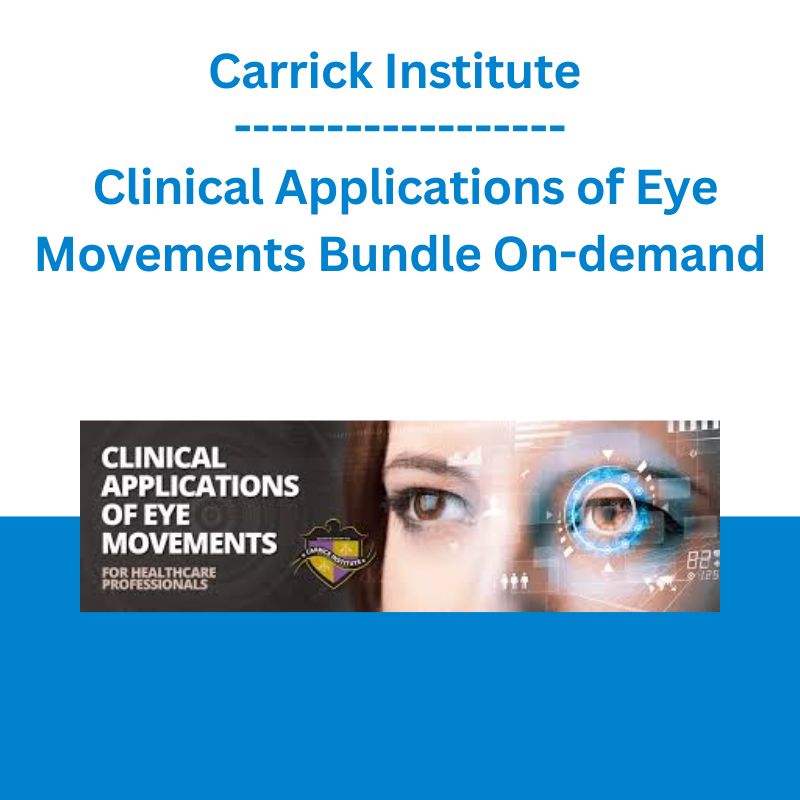*** Proof of Product ***

Exploring the Essential Features of “Carrick Institute – Clinical Applications of Eye Movements Bundle On-demand”
Clinical Applications of Eye Movements for Healthcare Professionals
MODULE 1: CLINICAL APPLICATIONS OF EYE MOVEMENTS
INSTRUCTOR: FREDERICK R CARRICK, DC, PHD, MS-HPED
This 25-hour clinical program is a comprehensive overview of the brain and eye movements highlighting hands-on examination and treatment protocols. A mastery of clinical examination procedures to quantify brain function and eye movements is necessary in the treatment of traumatic brain injuries and neurodegenerative diseases. Our participants will be trained to this level of mastery after completion of this course.
MODULE 2: ADVANCED CLINICAL APPLICATIONS OF EYE MOVEMENTS
INSTRUCTOR: FREDERICK R CARRICK, DC, PHD, MS-HPED
This clinical applications series is an advanced clinical experience that expands the clinicians ability to utilize eye movements to understand, diagnose and treat disorders of the nervous system. The advanced clinical module expands and details information that was learned in the Carrick Institute Clinical Applications of Eye Movements module.
This program builds upon the previous clinical learning module; as it is an expansion and progression of clinical skill acquisition necessary for the diagnosis and treatment a variety of neurological conditions. Clinical scholars will be able to master skills without the use of complex, expensive technology. This is a program designed for healthcare providers at the bedside. Observational strategies and the ability to design specific patient-centered treatments are the associated goals of this learning experience.
The program includes an in-depth understanding of eye movements and brain control as well as eye movements and brain influences. The clinical scholar will be able to understand, develop and apply treatment stratagems specific for individual areas of the nervous system.
Visual gaze specific to disorders of the pons and midbrain will be understood with specific diagnostic and therapeutic applications developed by the clinical scholar. The interactions between the cerebellum and the cerebral cortex are responsible for complex human motion including eye movements. The brainstem projection system promotes the interaction between these central areas.
An understanding of gaze promotes the development of both saccades and pursuits that allow individuals to participate in their activities of daily life. Key structures involved in horizontal and vertical gaze allow the clinician to physiologically test specific areas of the integrated nervous system with direction towards clinical applications.
The function of the Medulla will be presented specific to vertigo, dizziness and Cerebrovascular phenomenology. The clinical scholar will develop a practical hands-on bedside experience that will enable him/her to master skill sets necessary to attend patients who suffer from clinical syndromes in the caudal brainstem.
Structures that are critical for eye-movement control are located in the medulla and promote integration from the vestibular system and from the complex inferior olivary nuclear system. Aberrant abilities to stabilize the eyes associated with pathological saccades, pursuits and vestibular eye movements may be evaluated at the bedside.
Clinical syndromes affecting the cerebellum are central to the understanding of eye movements and brain function. Exacting detail in cerebellar syndromes with resultant extra ocular phenomenology will be explored. The optimization of central neurological function through cerebellar integration allows humankind to maintain both muscle tone and equilibrium. The functional regions of the cerebellum will be explored specific to the syndromes and clinical implications that might be specific to human performance.
The clinical examination of eye movements demands an understanding of the integration of visual saccades, pursuits, optokinetic responses, gaze stability, human stance, posture, and gait. Central to this understanding is a comprehensive clinical mastery of brain function associated with the integrity of humankind.
Who is this class for?
This program is designed for healthcare professionals who attend patients with neurological injury and disease. It is of special interest to those clinicians who attend patients who have suffered sports concussions as well as neurodegenerative diseases. Eye movements are validated biomarkers that are utilized in an evidence-based contemporary practice. Our program is specific for the clinical needs of the modern healthcare practitioner. As such, it is a hands-on program that trains the participant to perform and interpret bedside examinations of patients without the need of sophisticated instrumentation or technology. More so, it provides the clinician with the skills necessary to develop evidence-based treatments for those patients who have suffered brain injuries and neurodegenerative disorders.
Benefits for learners
Our scholars benefit from an advanced pedagogical methodology that promotes mastery of the clinical subject material. Participants will be involved in hands-on examination and interpretation of eye movements. Further, they will be trained in the development of treatment paradigms specific to the clinical findings that they observe. They will be instructed in the design and creation of a clinical practice that might utilize these skills. Participants will receive a copy of the live-class via on-demand for one year, and 3 months of unlimited access to Medline.
Our pedagogy
Candidates in our program will be given access to their flipped classroom and are expected to engage themselves in self-study and preparation before the hands-on interactive learning module begins. They also will be exposed to an interactive learning paradigm which is central upon participation in questions and responses that will direct the scholar towards a mastery of complex material.
We want our participants to develop lifelong learning skills and mastery of their clinical applications. Participants in our program will receive a continuous follow-up of training that is delivered to their smart phone, tablets, or computer after they have completed the program at no additional cost.
All participants are given access to the Carrick Institute library and Medline access. They will have direct access to published scientific papers that will complement their learning and increase their clinical skills.
How do I attend?
Participants can attend our program at the Carrick Institute learning Center in Cape Canaveral or by a synchronous live video streaming at a location of their choice. Our institutional technology guarantees a high definition interactive participation for those clinicians who choose to attend our program at a distance.
Why Carrick Institute
The Carrick Institute has provided clinical graduate school education for healthcare professionals for four decades. Our faculty are experienced clinician educators that have an international reputation for excellence. Our course instructor is recognized throughout the world for his clinical applications in this knowledge area. Professional athletes, Olympians, Collegiate athletes, celebrities and more call on him from around the world when they have suffered brain injury or neurological compromise. His work is the award-winning subject of a PBS documentary and he has been featured in major television and newspaper articles for decades.
What our participants will learn advanced topics on
- Examination skills of brain function
- Examination of voluntary and reflexogenic eye movements
- Examination of the visual striate cortex
- Examination of the medial superior temporal and middle temporal areas
- Examination of the frontal cortex
- Examination of the dorsolateral prefrontal cortex
- Examination of frontal eye fields
- Examination of supplementary high fields
- Examination of the superior colliculus
- Examination of the Pontine para-medial reticular formation
- Development of clinical treatments associated with disorders of the brain
These examination procedures promote localization and differential diagnoses of the nervous system.
Mastery of Advanced Clinical Procedures Involving Eye Movements
- Saccade tests
- Antisaccadic tests
- Head and eye saccades
- Visual pursuits
- Reflexogenic eye movement tests
- Volitional eye movement tests
- Vestibular tests
- Gaze fixation tests
- Optokinetic tests
Mastery of the understanding advanced concepts of the descending pathways involved in eye movements and their clinical applications
- Examination procedures that are specific to quantified the functional connections between the brain and brainstem
- Examination procedures that are specific for the Neostriata and basal ganglia
- Examination procedures that are specific for the subthalamic nucleus
- Examination procedures that are specific to the integration of major structures that projec to brainstem saccadic generators
- Examination procedures that are specific to the classification of fast and slow eye movements
- Diagnostic interpretation of pathology of functional eye movements
Brain function and the smooth pursuit system
- Examination procedures to identify function of the descending smooth pursuit pathway
- Examination procedures to identify the integration of cortical, subcortical and cerebellar influences to smooth pursuit function
- Interpretation of clinical signs specific to anatomical localization and neurophysiological function of the nervous system
- Understanding the functional deficits and compensation of specific lesions in the brain, basal ganglia, thalamus, cerebellum, brainstem and spinal cord and the development of treatment therapies specific to identified lesions
- Examination procedures that can identify pathology of function versus ablative pathology of smooth pursuit systems.
- Examination procedures specific to vestibular integration and eye movements
Clinical skills associated with vergence eye movements
- Clinical examination procedures of near and far visual perception
- Clinical treatment applications using environmental stimuli to affect vergence eye movements
- Clinical examination procedures specific to the midbrain
- Clinical examination procedures specific to the pons
- Clinical examination procedures specific to the cerebellum
Understanding the extraocular motor system
- Clinical examinations to quantified the pulse – step of neural integration
- Clinical examinations to measure pulse – step mismatches
- Clinical examinations to quantify the integrity of the brainstem generator
- Clinical examinations to quantify saccadic latency, velocity, duration and accuracy
The development of therapeutic treatment interventions
- Rubrics to assist in treatment development
- How to create a therapeutic practice
- How to increase beneficial clinical outcomes
- How to decrease failed clinical outcomes
Please see the full list of alternative group-buy courses available here: https://lunacourse.com/shop/









